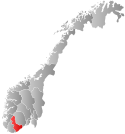Gjøvdal (historic: Gjevedal) is a former municipality in the old Aust-Agder county in Norway. The municipality existed from 1908 until its dissolution in 1960. It covered the Gjøv river valley and the surrounding moors. It is currently part of the municipality of Åmli in Agder county. The administrative centre was the village of Askland where Gjøvdal Church is located.[4]
Gjøvdal Municipality
Gjøvdal herred | |
|---|---|
| Gjevedal herred (historic name) | |
 View of the local Gjøvdal Church | |
 Aust-Agder within Norway | |
 Gjøvdal within Aust-Agder | |
| Coordinates: 58°52′18″N 08°18′14″E / 58.87167°N 8.30389°E | |
| Country | Norway |
| County | Aust-Agder |
| District | Østre Agder |
| Established | 1 Jan 1908 |
| • Preceded by | Åmli Municipality |
| Disestablished | 1 Jan 1960 |
| • Succeeded by | Åmli Municipality |
| Administrative centre | Askland |
| Population (1960) | |
• Total | 362 |
| Official language | |
| • Norwegian form | Nynorsk[1] |
| Time zone | UTC+01:00 (CET) |
| • Summer (DST) | UTC+02:00 (CEST) |
| ISO 3166 code | NO-0930[3] |
History
editThe parish of Gjøvdal (originally spelled Gjevedal) was part of the municipality of Åmli since 1 January 1838 (see formannskapsdistrikt law). On 1 January 1908, the municipality of Åmli was split into three separate municipalities: Gjevedal (population: 590), Lille Topdal (population: 389), and Åmli (population: 2,024). In 1911, the name Gjevedal was changed to "Gjøvdal".[5]
During the 1960s, there were many municipal mergers across Norway due to the work of the Schei Committee. On 1 January 1960, the municipality of Gjøvdal (population: 362) was reunited with Åmli (population: 1,947) to form a new, enlarged Åmli municipality. (The municipality of Tovdal was merged into Åmli in 1967.)[5][4]
Name
editThe municipality (originally the parish) is named after the Gjevedal valley (Old Norse: Gefardalr). The first element of the name comes from the name of the river Gjøv (Old Norse: Gef) which flows through the valley. That name comes from the verb gefa which means "to give someone something". The last element is dalr which means "valley" or "dale". Thus, "the valley that gives"[6] Historically, the name of the municipality was spelled Gjevedal. On 18 September 1914, a royal resolution changed the spelling of the name of the municipality to Gjøvdal.[7]
Government
editWhile it existed, this municipality was responsible for primary education (through 10th grade), outpatient health services, senior citizen services, unemployment, social services, zoning, economic development, and municipal roads. During its existence, this municipality was governed by a municipal council of directly elected representatives. The mayor was indirectly elected by a vote of the municipal council.[8]
Municipal council
editThe municipal council (Herredsstyre) of Gjøvdal was made up of 13 representatives that were elected to four year terms. The tables below show the historical composition of the council by political party.
| Party name (in Norwegian) | Number of representatives | |
|---|---|---|
| Labour Party (Arbeiderpartiet) | 9 | |
| Farmers' Party (Bondepartiet) | 4 | |
| Total number of members: | 13 | |
| Party name (in Norwegian) | Number of representatives | |
|---|---|---|
| Labour Party (Arbeiderpartiet) | 7 | |
| Joint List(s) of Non-Socialist Parties (Borgerlige Felleslister) | 5 | |
| Total number of members: | 12 | |
| Party name (in Norwegian) | Number of representatives | |
|---|---|---|
| Labour Party (Arbeiderpartiet) | 7 | |
| Joint List(s) of Non-Socialist Parties (Borgerlige Felleslister) | 5 | |
| Total number of members: | 12 | |
| Party name (in Norwegian) | Number of representatives | |
|---|---|---|
| Labour Party (Arbeiderpartiet) | 7 | |
| Joint List(s) of Non-Socialist Parties (Borgerlige Felleslister) | 5 | |
| Total number of members: | 12 | |
| Party name (in Norwegian) | Number of representatives | |
|---|---|---|
| Labour Party (Arbeiderpartiet) | 7 | |
| Joint list of the Farmers' Party (Bondepartiet) and the Liberal Party (Venstre) | 5 | |
| Total number of members: | 12 | |
| Note: Due to the German occupation of Norway during World War II, no elections were held for new municipal councils until after the war ended in 1945. | ||
See also
editReferences
edit- ^ "Norsk Lovtidende. 2den Afdeling. 1932. Samling af Love, Resolutioner m.m". Norsk Lovtidend (in Norwegian). Oslo, Norway: Grøndahl og Søns Boktrykkeri: 453–471. 1932.
- ^ "Forskrift om målvedtak i kommunar og fylkeskommunar" (in Norwegian). Lovdata.no.
- ^ Bolstad, Erik; Thorsnæs, Geir, eds. (26 January 2023). "Kommunenummer". Store norske leksikon (in Norwegian). Kunnskapsforlaget.
- ^ a b Thorsnæs, Geir, ed. (20 June 2015). "Gjøvdal". Store norske leksikon (in Norwegian). Kunnskapsforlaget. Retrieved 18 December 2017.
- ^ a b Jukvam, Dag (1999). "Historisk oversikt over endringer i kommune- og fylkesinndelingen" (PDF) (in Norwegian). Statistisk sentralbyrå. ISBN 9788253746845.
- ^ Rygh, Oluf (1905). Norske gaardnavne: Nedenes amt (in Norwegian) (8 ed.). Kristiania, Norge: W. C. Fabritius & sønners bogtrikkeri. p. 54.
- ^ "Norsk Lovtidende. 2den Afdeling. 1914. Samling af Love, Resolutioner m.m". Norsk Lovtidend (in Norwegian). Oslo, Norway: Grøndahl og Søns Boktrykkeri: 376. 1914.
- ^ Hansen, Tore; Vabo, Signy Irene, eds. (20 September 2022). "kommunestyre". Store norske leksikon (in Norwegian). Kunnskapsforlaget. Retrieved 1 January 2023.
- ^ "Kommunevalgene og Ordførervalgene 1955" (PDF) (in Norwegian). Oslo: Statistisk sentralbyrå. 1957. Retrieved 21 December 2020.
- ^ "Kommunevalgene og Ordførervalgene 1951" (PDF) (in Norwegian). Oslo: Statistisk sentralbyrå. 1952. Retrieved 21 December 2020.
- ^ "Kommunevalgene og Ordførervalgene 1947" (PDF) (in Norwegian). Oslo: Statistisk sentralbyrå. 1948. Retrieved 21 December 2020.
- ^ "Kommunevalgene og Ordførervalgene 1945" (PDF) (in Norwegian). Oslo: Statistisk sentralbyrå. 1947. Retrieved 21 December 2020.
- ^ "Kommunevalgene og Ordførervalgene 1937" (PDF) (in Norwegian). Oslo: Statistisk sentralbyrå. 1938. Retrieved 21 December 2020.
External links
edit- Aust-Agder travel guide from Wikivoyage